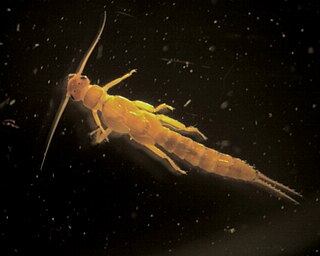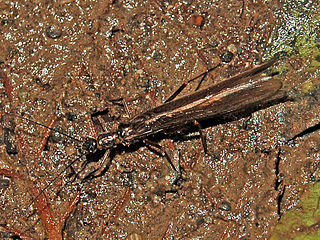
The Bibionomorpha are an infraorder of the suborder Nematocera. One of its constituent families, the Anisopodidae, is the presumed sister taxon to the entire suborder Brachycera. Several of the remaining families in the infraorder are former subfamilies of the Mycetophilidae, which has been recently subdivided. The family Axymyiidae has recently been removed from the Bibionomorpha to its own infraorder Axymyiomorpha.

Taeniopterygidae are a family of stone flies with about 110 described extant species. They are commonly called willowflies or winter stoneflies and have a holarctic distribution. Adults are usually smaller than 15 mm.

The Perlodidae, also known as the perlodid stoneflies, stripetails, or springflies, are a family of stoneflies.

The Perlidae are a family of stoneflies, with more than 50 genera and 1,100 described species. The majority of the Perlidae are found in eastern North America, but they occur worldwide except for Antarctica and parts of Africa. Their lifecycles range between one and three years. The adults emerge in the summer; they are very active and known to be attracted to light sources. They are usually very sensitive to changes in environment.

The Nemouridae are a family of stoneflies containing more than 700 described species, occurring primarily in the Holarctic region. Members of this family are commonly known as spring stoneflies or brown stoneflies. Fly fishermen often refer to these insects as tiny winter blacks.

The Capniidae, the small winter stoneflies, are a family of insects in the stonefly order (Plecoptera). It constitutes one of the largest stonefly families, containing some 300 species distributed throughout the holarctic. Their closest relatives are the rolled-winged stoneflies (Leuctridae).

Chloroperlidae are a family of stoneflies, commonly known as green stoneflies, with more than 200 species and 22 genera. They appear green to yellow in colour, and are popularly used among fisherman as bait for trout fishing. Green stoneflies live in the benthic zone of the cold streams and rivers of five continents and four zoogeographical regions, emerging from the water to live in the riparian zone as adults. They are sensitive to pollutants, making them an indicator species for determining the quality of water bodies. Chloroperlidae are hemimetabolous, having no pupal stage, but instead hatch from eggs as nymphs and mature directly into adults. They are omnivorous, feeding on small organisms and plant particles, and become more carnivorous as they mature. The classification of Chloroperlidae is contested, with some believing that they should be considered as members of different orders, as opposed to the order Plecoptera that they currently belong to.

Isoperla is a genus of Palaearctic and Nearctic stoneflies in the subfamily Isoperlinae and the family Perlodidae.

The Leuctridae are a family of stoneflies. They are known commonly as rolled-winged stoneflies and needleflies. This family contains at least 390 species.
This taxonomy of the Dermaptera follows Engel & Haas (2007) to the rank of genus.

The clade Multicrustacea constitutes the largest superclass of crustaceans, containing approximately four-fifths of all described non-hexapod crustacean species, including crabs, lobsters, crayfish, shrimp, krill, prawns, woodlice, barnacles, copepods, amphipods, mantis shrimp and others. The largest branch of multicrustacea is the class Malacostraca.

Paragnetina is a genus of common stoneflies in the family Perlidae. There are at least 20 described species in Paragnetina.

Perlodini is a tribe of Palaearctic and Nearctic stoneflies in the family Perlodidae. There are more than 80 described species in Perlodini.

Acroneuria is a genus of common stoneflies in the family Perlidae. There are more than 30 described species in Acroneuria.
Megarcys is a genus of springflies in the family Perlodidae. There are about 11 described species in Megarcys.

Gripopterygidae is a family of stoneflies in the order Plecoptera. There are more than 50 genera and 320 described species in Gripopterygidae.













